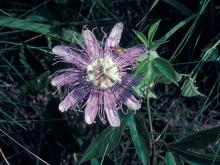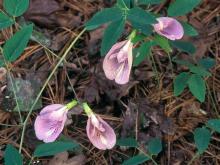Wildflowers, Grasses and Other Nonwoody Plants
Media

Species Types
Scientific Name
Commelina communis
Description
The flowers of dayflower are truly blue, and they have only two conspicuous petals. A fast-growing, sprawling, but shallow-rooted weed, this introduced species commonly annoys gardeners.
Media

Species Types
Scientific Name
Passiflora incarnata
Description
The bizarre, complicated flowers attract attention! The fruits are edible. Passion flower is a nonwoody vine that climbs via tendrils on trees or other structures. It is native to the southeastern United States, including southern Missouri.
Media

Species Types
Scientific Name
Clitoria mariana
Description
Butterfly pea is a low, shrubby, or twining perennial in the pea family, with showy, butterfly-like flowers. The leaves are compound with three leaflets. This species grows in the southern parts of Missouri, in acid soils.
Media

Species Types
Scientific Name
Lathyrus latifolius
Description
Everlasting pea is an old-fashioned garden plant your grandma might have grown on a fence. Native to the Old World, it often persists at old homesites.
Media

Species Types
Scientific Name
Mimosa quadrivalvis (also Schrankia nuttallii)
Description
Sensitive briar is a dainty-looking legume with delicate, twice-compound leaves and flower heads resembling magenta pom-poms. The long, tough stems are covered with tiny thorns that snag your feet as you walk.
Media

Species Types
Scientific Name
Subfamily Asclepiadoideae
Description
Milkweeds are a group of plants that used to have their very own family. Now part of the dogbane family, they’re still a pretty distinctive group.
See Also
About Wildflowers, Grasses and Other Nonwoody Plants in Missouri
A very simple way of thinking about the green world is to divide the vascular plants into two groups: woody and nonwoody (or herbaceous). But this is an artificial division; many plant families include some species that are woody and some that are not. The diversity of nonwoody vascular plants is staggering! Think of all the ferns, grasses, sedges, lilies, peas, sunflowers, nightshades, milkweeds, mustards, mints, and mallows — weeds and wildflowers — and many more!





















